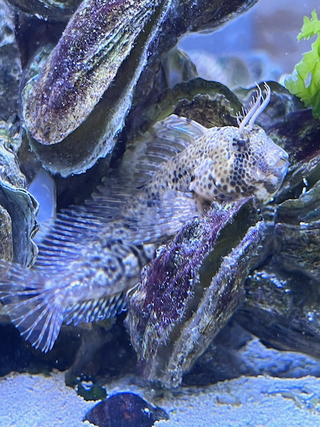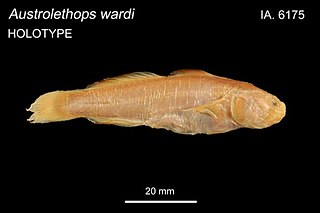
The sarcastic fringehead is a small but hardy saltwater tube-blenny that possesses a large mouth and aggressive territorial behavior, for which it has been given its common name. The specific name honours Dr. S. B. Blanchard of San Diego, California, who collected specimens of this blenny, and passed them on to Charles Frédéric Girard, who described it.

Mudskippers are any of the 23 extant species of amphibious fish from the subfamily Oxudercinae of the goby family Oxudercidae. They are known for their unusual body shapes, preferences for semiaquatic habitats, limited terrestrial locomotion and jumping, and the ability to survive prolonged periods of time both in and out of water.

Odontamblyopus lacepedii, also known as warasubo, is a species of eel goby found in muddy-bottomed coastal waters in China, Korea and Japan. This species excavates elaborate vertical burrows up to 90 centimetres (35 in) long in the sea bed. This species can reach a length of 30.3 centimetres (11.9 in) SL. The specific name honours the French naturalist and politician Bernard-Germain-Étienne de La Ville-sur-Illon, comte de Lacépède, publisher of the 5 volume Histoire Naturelle des Poissons who is reported to have illustrated this species under the name Taenioïde Herrmannien. The species is edible.

Fries's goby is a species of goby native to the Eastern Atlantic Ocean along the coasts of Europe and northern Africa as well as the Mediterranean Sea to the Sea of Marmara. This species burrows into muddy or muddy sand substrates at depths of from 10 to 130 metres and is frequently found in association with the Norway lobster Nephrops norvegicus. This species can reach a length of 13 centimetres (5.1 in) TL. The specific name honours the Swedish zoologist Bengt Fredrik Fries (1799-1839).
The short-snout sand-dragonet is a species of dragonet native to the eastern Indian Ocean and the western Pacific Ocean where it is found at a depth of around 8 metres (26 ft). It prefers muddy or sandy substrates, preferring areas near river mouths or estuaries. This species grows to a length of 6.5 centimetres (2.6 in) TL. The specific name honours Dirk François Schaap, a Dutch colonial administrator in the Dutch East Indies who lived on Bangka Island, Sumatra, who found this species.

Hypsoblennius hentz, commonly known as the feather blenny, is a species of combtooth blenny found on coral reefs in the western Atlantic Ocean. This species grows to a length of 10 centimetres (3.9 in) total length. The feather blenny is found from Nova Scotia, Canada to Texas along the shore of North America. Often, feather blennies can be found in oyster reefs and rocky shores. The identity of the person honoured in this species' specific name is uncertain but it is thought that to have been the French American arachnologist Nicholas Marcellus Hentz (1797-1856) who is the "Mr Hentz" from Charleston, North Carolina who sent the type to Lesueur.
Gobioclinus guppyi, the mimic blenny, is a species of labrisomid blenny native to the western Atlantic Ocean and the Caribbean Sea from south Florida to Fernando de Noronha. It inhabits areas such as reefs, near shore areas with rock or rubble covered in algae, and in beds of seagrass. This species can reach a length of 11.5 centimetres (4.5 in) TL. The specific name honours Robert Lechmere Guppy who collected the type and sent it to the British Museum, he was also the father of Robert John Lechmere Guppy who discovered the guppy.

Couch's goby is a species of goby native to the northeastern Atlantic Ocean as far north as southern Great Britain and Ireland, the Mediterranean Sea and the Adriatic Sea where it can be found living under stones on muddy sand in inshore waters and in the intertidal zone. This species can reach a length of 7.7 centimetres (3.0 in) TL. The specific name and common name both honour Jonathan Couch (1789–1870), the Cornish ichthyologist and the author of A History of the Fishes of the British Islands published between 1862 and 1867.
Gobius gasteveni, Steven's goby, is a species of goby native to the eastern Atlantic Ocean where it is known to occur in the Irish sea as far north as the Isle of Man, the western part of the English Channel south as far as Madeira and the Canary Islands. It can be found in areas with substrates of muddy sand with coarser deposits at depths of from 35 to 270 metres. This species can reach a length of 12 centimetres (4.7 in) TL. The common name and the specific name both honour the British ichthyologist G. A. Steven BSc FRSE (1901-1958), of the Plymouth Marine Laboratory, who worked extensively on the fish fauna of the English Channel and who identified this species as being new to that area.
Ben-Tuvia's goby is a species of goby native to the Mediterranean Sea along the coast of Israel where it can be found on muddy sand bottoms at around a depth of 37 metres (121 ft). Both the specific name and the common name honour the Israeli ichthyologist Adam Ben-Tuvia (1919-1999) of the Hebrew University of Jerusalem, who collected type and who has made a significant contribution to the knowledge of the Mediterranean fish fauna.

Periophthalmodon is a genus of mudskippers found along muddy shores, estuaries and lower reaches of rivers in Southeast Asia, Papua New Guinea and Queensland, Australia.
Peter Robert Last is an Australian ichthyologist, curator of the Australian National Fish Collection and a senior principal research scientist at CSIRO Marine and Atmospheric Research (CMAR) in Hobart, Tasmania. He is an elasmobranch expert and has described many new species of shark.
Gerald Robert "Gerry" Allen is an American-born Australian ichthyologist. His career began in 1963, when he spent a semester at the University of Hawaii, where he also received a PhD in marine zoology in 1971. In 1972, Allen wrote his doctoral thesis on the systematics and biology of the anemone fish.

The small-eyed goby is a species of goby native to tropical reefs of the Indian Ocean through the western Pacific Ocean where it inhabits areas of coral rubble. As its common name suggests, this species has particularly small eyes. This species grows to a length of 6 centimetres (2.4 in) TL. This species is the only known member of its genus. The small-eyed goby is specialised to feed on seagrass and they share a burrows with mud lobsters of the genus Thalassina. The specific name honours Charles Melbourne Ward (1903-1966), the Australian actor, naturalist and collector of specimens who collected the type specimen.
Hemerorhinus opici is an eel in the family Ophichthidae. It was described by Jacques Blache and Marie-Louise Bauchot in 1972. It is a marine, tropical eel which is known from the eastern Atlantic Ocean, including Senegal and Angola. It inhabits shallow waters near to shore, and forms burrows in sand and mud substrates. Males can reach a maximum total length of 32.5 centimetres (12.8 in).
Karsten totoyensis is a species of goby native to the western Pacific Ocean where it has been recorded from the Philippines, Fiji and Indonesia. This species can be found over muddy or sandy substrates usually down to a depth of 55 metres (180 ft), but it has been recorded down to a depth of 1,122 metres (3,681 ft). This species grows to a length of 4.8 centimetres (1.9 in) SL.
Darwin's mudskipper is a relatively newly discovered mudskipper in 2004, so little is known about it. It is a brackish water ray-finned fish found in Australia along mud banks never far from mangrove trees. It is in the goby family Gobiidae. It is named after Charles Darwin because the holotype was collected in Darwin Harbour. Its greatest distinguishing characteristic from other mudskippers is its greatly reduced first dorsal fin in both sexes.

Periophthalmodon freycineti, the pug-headed mudskipper, is a species of mudskipper from the subfamily Oxudercinae of the gobiiform family Oxudercidae. It distribution extends from the Philippines through eastern Indonesia, Papua New Guinea and northern Queensland. Its habitat is tidal creeks, mud banks and inlets where it is a predator on small fish, crabs and other invertebrates such as insects. The specific name honours the French explorer Louis de Freycinet (1779-1841), the leader of the expedition on which the type was collected.

Periophthalmodon septemradiatus is a species of mudskipper found along tropical shorelines of the eastern Indian Ocean where it occurs in marine, brackish and fresh waters from India to Mekong Delta Vietnam, Indonesia. It is found along in estuaries as well as in the rivers.
Nikolai Vasilyevich Parin was a Soviet and Russian ichthyologist, specializing in oceanic pelagic fish. He headed the Laboratory of Oceanic Ichthyofauna at the RAS Institute of Oceanology in Moscow, where he ended his career as a Professor after more than fifty-seven years. In his career, he described more than 150 new taxa of fish and participated in 20 major oceanic expeditions. Thirty-six species of fish are named in his honour.











